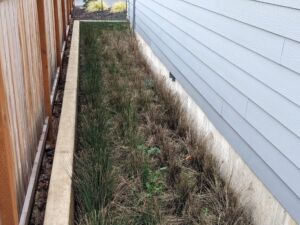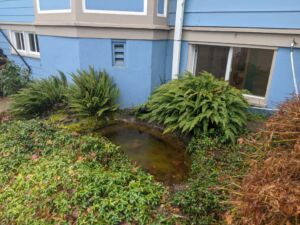
Discharging stormwater at the foundation of a home can lead to several significant issues. One primary concern is the potential for water infiltration into the foundation, which can compromise the structural integrity of the building over time. Excessive moisture around the foundation may result in foundation cracks, basement leaks and even structural damage. Furthermore, constant water exposure can create a conducive environment for mold growth, posing health risks and requiring expensive remediation efforts. To mitigate these issues, it is essential to implement proper stormwater management measures, including the use of drainage systems, grading, and landscaping features that redirect water away from the foundation and promote controlled infiltration.
Uncontrolled stormwater runoff can lead to soil erosion, which can undermine the stability of the ground around your property. Proper stormwater management helps reduce the risk of flooding by controlling the flow of water and preventing excessive accumulation. Stormwater runoff can carry pollutants such as sediment, chemicals, and debris, which can contaminate water bodies. On-site management systems filter and treat stormwater before it reaches natural water sources.

There may be regulations specifying the minimum distance that stormwater management features should be from buildings to prevent potential damage. For example, the City of Portland has published an article about these systems on their website and recommends that the edge of rain gardens not be installed closer than 6 feet for homes with a basement and 2 feet for homes without a basement. Different local jurisdictions will require different guidelines, so be sure to check with your local code enforcement prior to installation of one of these systems at your home. Requirements may depend on the size of the property, its slope, soil type, and other factors that affect stormwater management. Depending on the jurisdiction, you may need permits for the installation of stormwater management systems.
Various Types of On-site Stormwater Management Systems:
Rain Gardens: These are shallow, landscaped depressions designed to capture and absorb stormwater, promoting infiltration and reducing runoff.
Permeable Pavements: These are surfaces that allow water to pass through, reducing runoff. Examples include permeable concrete, asphalt, or paving stones.
Retention and Detention Basins: These are constructed depressions that temporarily store stormwater, allowing sediments to settle before slowly releasing the water.
Green Roofs: Vegetated roofs that absorb and slow stormwater runoff, providing insulation and other environmental benefits.
Bioretention Cells: Similar to rain gardens, these are shallow, landscaped depressions designed to capture and treat stormwater.
Stormwater Filtration Systems: Mechanical systems designed to filter out pollutants from stormwater runoff before it is discharged.
Dry Wells: A dry well is a type of stormwater management system designed to collect and temporarily store stormwater runoff and allow it to gradually infiltrate into the ground. It is essentially a large, underground chamber or pit (oftentimes filled with a permeable material such as gravel or rocks) that receives rainwater or surface runoff and allows it to percolate into the surrounding soil.
Before implementing any stormwater management system, it’s essential to consult with local authorities, adhere to regulations, and consider the specific characteristics of your property to ensure effective and compliant solutions.
